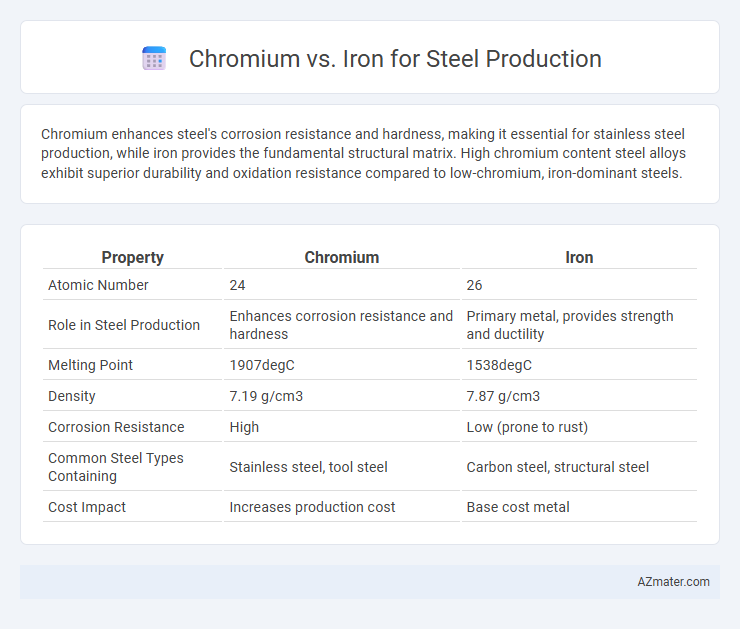Chromium enhances steel's corrosion resistance and hardness, making it essential for stainless steel production, while iron provides the fundamental structural matrix. High chromium content steel alloys exhibit superior durability and oxidation resistance compared to low-chromium, iron-dominant steels.
Table of Comparison
| Property | Chromium | Iron |
|---|---|---|
| Atomic Number | 24 | 26 |
| Role in Steel Production | Enhances corrosion resistance and hardness | Primary metal, provides strength and ductility |
| Melting Point | 1907degC | 1538degC |
| Density | 7.19 g/cm3 | 7.87 g/cm3 |
| Corrosion Resistance | High | Low (prone to rust) |
| Common Steel Types Containing | Stainless steel, tool steel | Carbon steel, structural steel |
| Cost Impact | Increases production cost | Base cost metal |
Introduction: Chromium and Iron in Steel Production
Chromium and iron are fundamental elements in steel production, where iron serves as the primary base metal providing strength and malleability. Chromium is added to steel alloys to enhance corrosion resistance, hardness, and surface finish, particularly in stainless steels. The balance between chromium and iron content determines the steel's properties, making these elements critical for tailoring steel performance in various industrial applications.
Chemical Properties: Chromium vs Iron
Chromium exhibits higher corrosion resistance and hardness compared to iron, making it essential for enhancing steel's durability and resistance to oxidation. Iron, with its atomic number 26, serves as the primary metal in steel but lacks the chemical stability chromium provides through the formation of a passive oxide layer. The addition of chromium (typically above 10.5%) transforms conventional steel into stainless steel, significantly improving chemical resistance and mechanical properties.
Role of Chromium in Steel Alloys
Chromium enhances steel alloys by significantly increasing corrosion resistance and hardness, making it essential for stainless steel production. Its ability to form a stable oxide layer prevents rust, improving durability in harsh environments. Compared to iron alone, chromium-alloyed steel exhibits superior strength and wear resistance, crucial for industrial and construction applications.
Influence of Iron on Steel Characteristics
Iron is the primary element in steel production, directly impacting its strength, ductility, and magnetic properties. The carbon content in iron governs hardness and tensile strength, while impurities like sulfur and phosphorus can reduce toughness. Iron's crystalline structure and purity levels determine the steel's malleability and resistance to corrosion.
Corrosion Resistance: Chromium’s Contribution
Chromium significantly enhances corrosion resistance in steel by forming a stable, thin oxide layer on the surface, preventing rust and degradation. In stainless steel, chromium content typically exceeds 10.5%, which is critical for maintaining durability in harsh environments. Iron alone lacks this protective oxide layer, making it more susceptible to oxidation and corrosion compared to chromium-alloyed steel.
Mechanical Strength: Comparing Chromium and Iron
Chromium significantly enhances the mechanical strength of steel by improving hardness, tensile strength, and wear resistance compared to pure iron. While iron provides basic structural integrity, the addition of chromium forms hard carbides that increase toughness and corrosion resistance in steel alloys. This combination results in steel grades that outperform iron in demanding applications such as automotive, construction, and tool manufacturing.
Cost and Availability in Steelmaking
Chromium and iron differ significantly in cost and availability for steel production, with iron being more abundant and cheaper, making it the primary base metal in steelmaking. Chromium, though more expensive and less abundant, is essential for producing stainless steel due to its corrosion resistance properties, which justify its higher cost in specialized steel grades. The balance between chromium's alloy benefits and iron's cost-effectiveness influences steel manufacturers' choices depending on the intended steel application and market demand.
Environmental Impact: Chromium vs Iron Extraction
Chromium extraction involves energy-intensive processes and the use of hazardous chemicals, leading to higher environmental pollution and waste compared to iron mining, which tends to have a lower ecological footprint. Chromium mining often results in toxic runoff and heavy metal contamination affecting local ecosystems, whereas iron extraction primarily generates large quantities of waste rock and tailings with comparatively fewer toxic substances. Steel production utilizing iron as the primary alloying metal benefits from more established recycling practices, reducing the need for virgin iron ore mining and minimizing environmental degradation relative to chromium-dependent processes.
Industrial Applications of Chromium and Iron Steel
Chromium enhances steel's corrosion resistance, hardness, and wear resistance, making it ideal for stainless steel used in chemical processing, automotive parts, and construction. Iron forms the base metal in steel production, providing strength and malleability essential for structural steel in buildings, bridges, and machinery. Industrial applications leverage chromium-alloyed steel for durability in harsh environments, while iron-steel dominates high-strength frameworks and general engineering.
Future Trends in Steel Production with Chromium and Iron
Future trends in steel production indicate increased utilization of chromium to enhance corrosion resistance and mechanical properties in stainless steel alloys, driven by growing demand in automotive and construction industries. Innovations in iron-based production focus on reducing carbon emissions through hydrogen-based direct reduction and electric arc furnace technologies, aiming for more sustainable steel manufacturing. Integration of advanced metallurgical processes enables optimized alloy compositions, balancing chromium and iron to achieve superior performance with lower environmental impact.

Infographic: Chromium vs Iron for Steel Production
 azmater.com
azmater.com